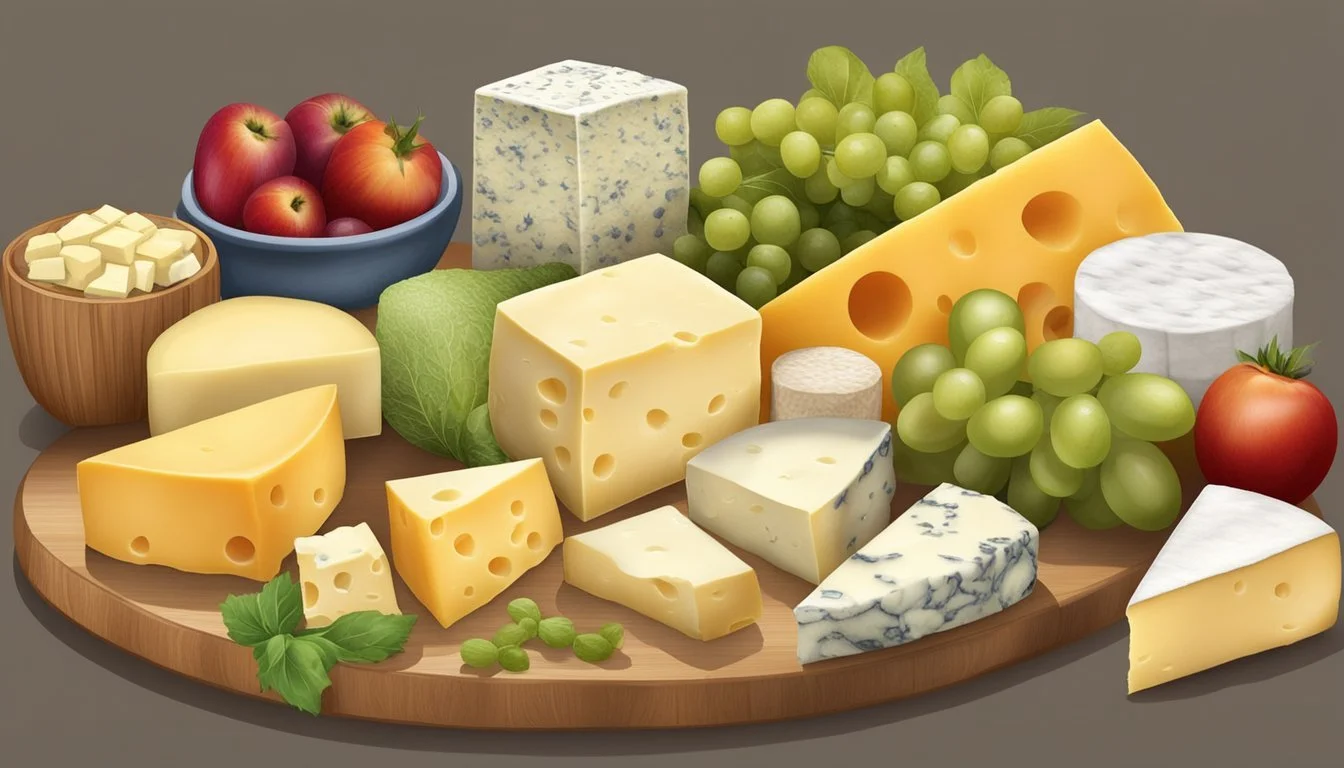Gorgonzola Cheese Substitutes
Top Alternatives for Your Recipes
Gorgonzola, an esteemed Italian cheese (What wine goes well with cheese?) originating from the town of Gorgonzola in Italy, is cherished for its rich, creamy texture and distinct blue mold veins that impart a sharp and slightly pungent flavor. This cheese has become a staple in various dishes, offering a bold taste that can elevate the simplest of recipes. However, not all palates or dishes suit its strong flavor, and in some instances, individuals may need alternatives due to dietary restrictions or availability concerns.
Several cheeses can serve as adequate substitutes for Gorgonzola without compromising the integrity of the dishes in which they're used. For instance, Bleu d'Auvergne, another European blue cheese, mirrors the characteristics of Gorgonzola with its cow’s milk origin and the presence of blue mold veins, though it carries a somewhat spicier note. On the milder side, goat cheese offers a consistency similar to Gorgonzola and is an agreeable replacement in salads, pizzas, and pastas for those seeking a more subdued flavor profile. Roquefort, with its rich creaminess and pungent taste derived from sheep’s milk, offers another alternative that shares many qualities with Gorgonzola, making it a viable option in recipes where this Italian cheese would typically star.
Understanding Gorgonzola
Gorgonzola cheese boasts a distinctive profile with roots in Lombardy, Northern Italy. This cheese is acclaimed for its strong flavor and versatility in various dishes, ranging from pasta to risotto.
Origins and Characteristics
Gorgonzola originated in the town of Gorgonzola, Lombardy, and is one of Italy's oldest blue cheeses. Traditionally made from unskimmed cow's milk, the cheese is known for its distinctive blue mold veins which give it a strong flavor and a creamy to crumbly texture, depending on its age. Gorgonzola has a unique production process that includes the introduction of specific mold spores and metal rods to encourage veining.
Region: Lombardy, Northern Italy
Milk Type: Cow's milk
Texture: Creamy to crumbly
Flavor Profile: Strong, sharp, sometimes slightly sweet
Varieties of Gorgonzola
There are primarily two varieties of Gorgonzola which are categorized based on their age and texture:
Gorgonzola Dolce: This is the younger, milder version with a creamy texture and a less assertive flavor.
Gorgonzola Piccante: Also known as Gorgonzola Naturale or Stagionato, this type is aged longer, resulting in a firmer, crumbly texture and a spicier taste.
Both varieties are protected with a PDO (Protected Designation of Origin) status, ensuring their quality and the traditional production process.
Culinary Uses
Gorgonzola is a versatile cheese that enhances various dishes.
Pasta & Risotto: Gorgonzola adds a rich depth to the creamy sauces typically served with these Italian staples.
Salads & Sauces: Its bold flavor can infuse dressings and compound butters, adding complexity to simple green salads or decadent steak sauces.
Recipes: Whether it's stirred into polenta, crumbled over a pizza, or melted into a quiche, Gorgonzola brings a robust taste that complements a variety of recipes.
Pasta Dishes often feature gorgonzola as a key ingredient to deliver a creamy and luscious experience. Each variety, Dolce or Piccante, offers a different level of intensity and can be selected based on the desired outcome of the dish.
Cheese Substitutes for Gorgonzola
When looking for substitutes for gorgonzola cheese, it's important to consider the cheese's creaminess and distinct tangy flavor. Varieties of cheeses from cow, sheep, and goat's milk, as well as non-dairy options, can offer similar textures and tastes to fit various dietary needs and flavor preferences.
Cow’s Milk Alternatives
Danish Blue and Bleu d'Auvergne are cow’s milk cheeses with creamy textures and blue mold veins comparable to gorgonzola. They deliver strong, pungent tastes, ideal for those who enjoy a more pronounced flavor profile. For a slightly different tang, Pecorino Romano, a hard Italian cheese, may also be grated over dishes to mimic gorgonzola's bold presence.
Danish Blue (Strong, pungent)
Bleu d'Auvergne (Spicy note)
Pecorino Romano (Salty tang)
Sheep’s and Goat’s Milk Options
For those preferring substitutes from sheep or goat's milk, Roquefort cheese is a prestigious option made from ewe's milk. It carries a creamy texture and a sharp taste similar to gorgonzola. Another consideration is Goat Cheese, with its milder flavor and versatile consistency that pairs well with salads and pasta, akin to gorgonzola.
Roquefort Cheese (Creamy, pungent kick)
Goat Cheese (Milder, versatile consistency)
Non-Dairy and Vegan Alternatives
Vegan alternatives avoid animal products altogether, utilizing ingredients such as soy products and nuts. Nut-based cheeses and soy products crafted with vegetable rennet can emulate gorgonzola's creaminess and are a suitable choice for vegan diets or those with dairy intolerances.
Nut-based cheeses (Creamy, tangy)
Soy products (Versatile, mimic dairy texture)
Pairing and Incorporation into Meals
When selecting a Gorgonzola substitute for a dish, one should consider how it pairs with other ingredients and how it can be incorporated into various meal types.
Recipes and Dish Inspiration
Pasta: Gorgonzola's creamy texture makes it ideal for pasta sauces. Cheeses like Roquefort with its creaminess or Feta, thanks to its crumbly nature, are commendable substitutes. To emulate the iconic tangy and salty profile in a pasta dish, one might opt for Pecorino Romano.
Risotto: Incorporating a cheese like Bleu d'Auvergne, slightly spicier yet with a significant tang, can complement the creamy consistency of risotto, maintaining the characteristic flavor one expects from blue cheese.
Salads: For salads that call for Gorgonzola, choose a cheese that can be crumbled easily, such as Goat Cheese or Feta. Dressing them with fruits and nuts can enhance the cheese's tanginess and add textural contrast.
Complementary Flavors and Textures
Salty and Tangy: Substitute cheeses that possess a fine balance between salt and tang can emulate Gorgonzola's distinguished taste. These might include Feta or Roquefort.
Creamy: For dishes requiring a creamy consistency, a soft cheese like Goat Cheese can be an excellent alternative and is also suitable as a milder-tasting pizza topping.
Blue Cheese Varieties: Cheeses with blue veins such as Bleu d'Auvergne pay homage to Gorgonzola's piquant nature and are an excellent choice for imparting bold flavors into cooking.
Serving Suggestions
Appetizer: Substitutes can be incorporated into a charcuterie (What wine goes well with charcuterie?) board; Roquefort or Bleu d'Auvergne pair nicely with fruits and nuts.
Dressing and Crumble: Use a cheese with a rich flavor profile, like Feta, to top salads or to create a Gorgonzola-style dressing.
Pizza and Bread: When used as a pizza topping or spread on bread, consider the melting qualities of your substitute cheese. Goat Cheese offers a creamy texture, while Pecorino Romano can provide a sharper, saltier note.
Health and Nutrition Considerations
When considering substitutes for Gorgonzola cheese, it is important to assess their health and nutritional profiles, especially in terms of calcium content, how they fit into dietary practices that require moderation, and their impact on dairy-related allergies and intolerances.
Benefits and Dietary Impact
Gorgonzola cheese is a notable source of calcium, which is essential for bone health. Substitutes such as Bleu d'Auvergne also provide this vital mineral. However, individuals must consume cheese in moderation due to its high fat and calorie content. Incorporating a variety of dairy products can contribute to a balanced diet, as long as they don't exceed recommended daily fat and calorie intake levels.
Calcium Content:
Gorgonzola: High
Bleu d'Auvergne: High
Pecorino Romano: Moderate to High
Considerations for Moderation:
Saturated Fat: Limit intake
Calories: Monitor for weight management
Allergies and Intolerances
Those with lactose intolerance may need to select cheeses that are naturally lower in lactose, such as aged cheeses like Pecorino Romano. For those with a dairy allergy, it's imperative to avoid Gorgonzola and its substitutes entirely and opt for non-dairy alternatives to prevent allergic reactions.
Lactose Intolerance:
Aged cheeses often have lower lactose levels and may be tolerated better.
Dairy Allergy:
Avoid all dairy-based cheeses.
Seek non-dairy cheese alternatives.
Purchasing and Storage Tips
Selecting the right cheese substitute for Gorgonzola and storing it appropriately will ensure that its flavor is preserved and that it retains its texture, whether creamy or crumbly. Proper storage also helps prolong shelf life and prevent mold.
Selecting the Best Substitute
When looking for a Gorgonzola cheese substitute, one should choose based on the desired flavor profile and corresponding aging process. Stronger flavors in a dish might be well-complemented by Pecorino Romano, which offers a tangy taste due to its extensive aging. Alternatives like Roquefort with a creamy texture or Bleu d'Auvergne, which is a bit spicier, can also serve as excellent choices depending on the recipe's requirements.
Storing Cheese for Freshness
Cheese should be stored in the fridge, ideally between 35°F and 40°F, to maintain freshness. For best results, wrap the cheese in parchment paper followed by a loose layer of plastic wrap, which allows the cheese to breathe and prevents excess moisture from encouraging mold growth. The storage technique differs slightly based on the cheese's texture:
Creamy cheeses: Store in a container with a lid to maintain humidity.
Crumbly cheeses: Keep in a drier part of the fridge to preserve the texture.
The shelf life of cheese varies; for example, hard cheeses like Pecorino Romano generally last longer than softer cheeses like Roquefort. Always check for any signs of spoilage before using.






